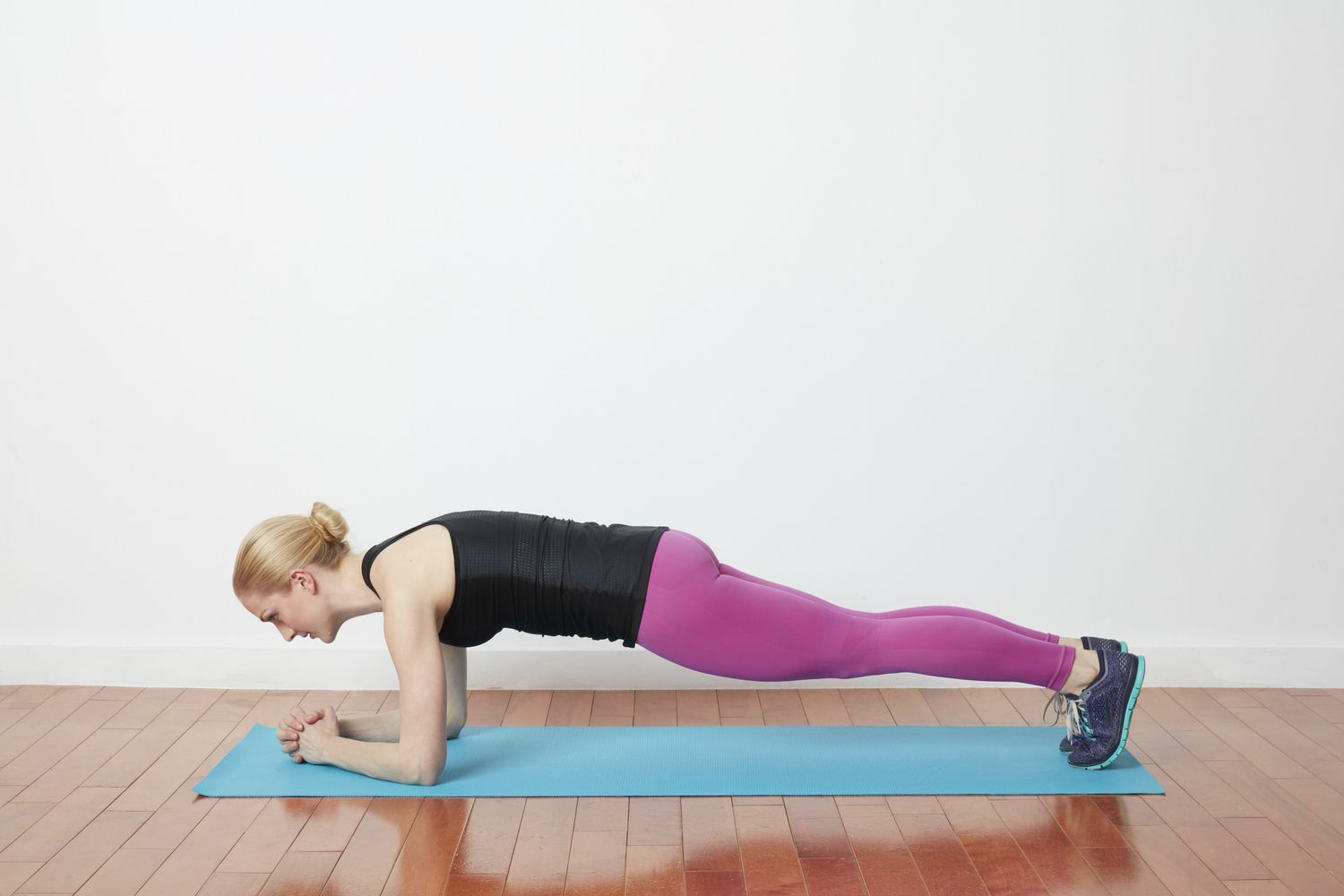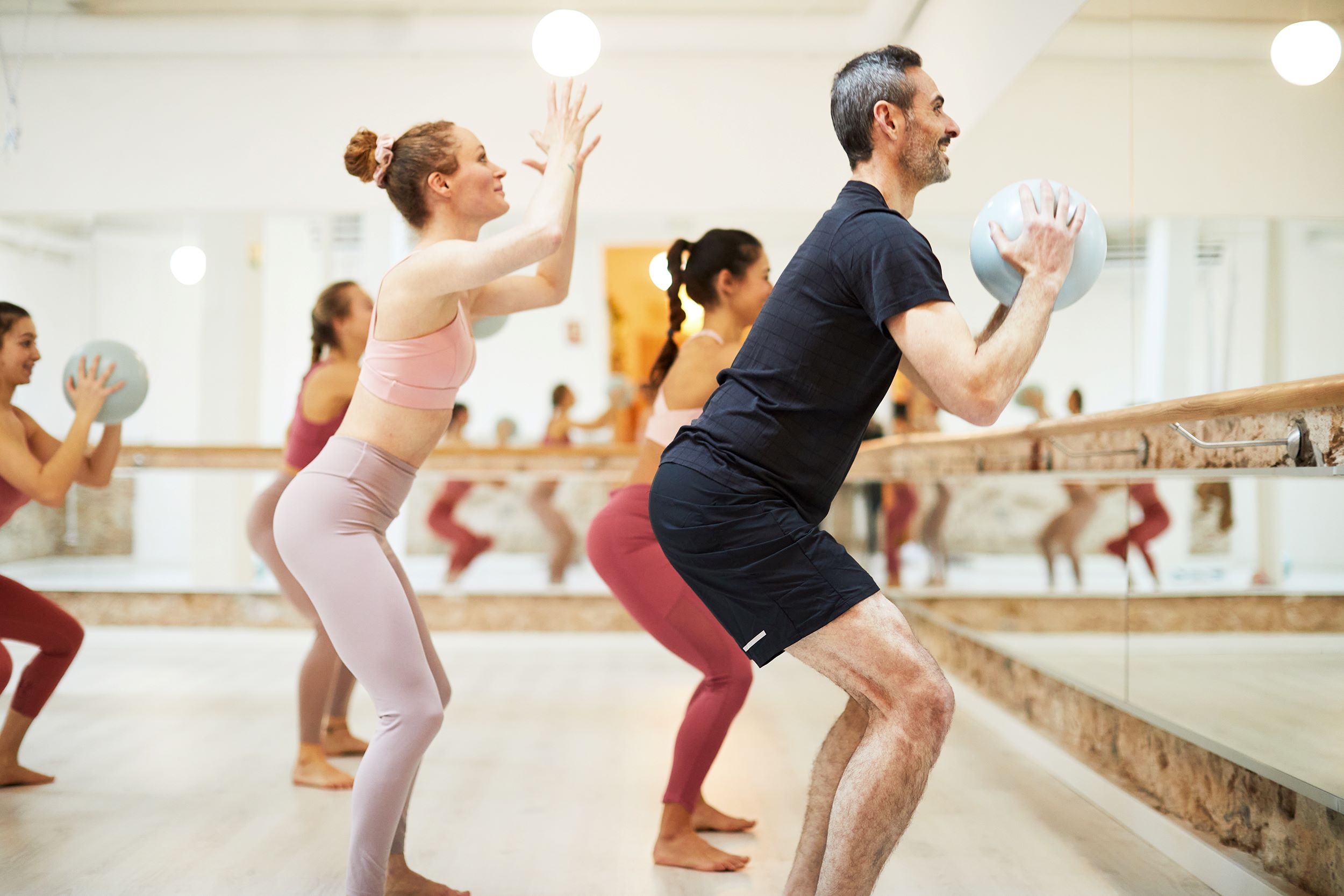

Featured
What Is An Isometric Exercise
Modified: January 2, 2024
Discover the benefits of featured isometric exercises and learn how they can help you build strength and improve muscle tone. Start incorporating these effective workouts into your fitness routine today!
Introduction
Isometric exercise is a type of strength training that involves contracting your muscles without movement. Unlike traditional exercises that require your muscles to lengthen and shorten, isometric exercises focus on exerting force against an immovable object or by holding a static position.
This form of exercise has been practiced for centuries and has gained popularity in recent years due to its numerous benefits. Whether you’re looking to build strength, improve muscle endurance, or enhance your overall fitness level, incorporating isometric exercises into your workout routine can be a game-changer.
Not only are isometric exercises highly effective in toning and strengthening specific muscle groups, but they also require minimal equipment and can be done virtually anywhere. Whether you’re at the gym, at home, or even in the office, you can sneak in a quick isometric exercise to keep your muscles engaged and maximize your workout.
In this article, we will delve deeper into the world of isometric exercises, exploring their definition, benefits, examples, and tips to perform them correctly and safely. By the end of this article, you’ll have a solid understanding of isometric exercises and be motivated to incorporate them into your fitness routine. So, let’s dive in!
Definition of Isometric Exercise
Isometric exercise is a form of strength training where you contract your muscles without any movement in the joints. Unlike dynamic exercises that involve repetitive movements, isometric exercises involve holding a single position for an extended period of time or pushing against an immovable object with maximum force.
During an isometric exercise, your muscles work against resistance, but without any visible change in their length. This is because the force generated by the muscles is equal to the resistance encountered, resulting in a static contraction. The term “isometric” itself means “same length,” referring to the constant muscle length during the exercise.
This type of exercise has been used in various disciplines, including physical therapy, rehabilitation, yoga, and martial arts. It places a significant amount of stress on the muscles, leading to increased muscular strength and endurance. By engaging multiple muscle groups simultaneously, isometric exercises provide a comprehensive workout and can target specific areas of the body.
Isometric exercises can be classified into two types: maximal and submaximal. Maximal isometric exercises involve contracting your muscles with maximum effort, exerting as much force as possible against the resistance. On the other hand, submaximal isometric exercises involve exerting less than maximum effort, allowing for longer durations of muscle contraction.
The goal of isometric exercises is to develop strength and stability in the targeted muscles and joints. Additionally, they can improve body awareness, posture, and muscular endurance. By incorporating isometric exercises into your fitness routine, you can enhance your overall physical performance and reduce the risk of injury.
It’s important to note that isometric exercise should be performed in conjunction with other types of exercise, such as cardiovascular activities and dynamic strength training, to achieve a well-rounded fitness regimen. This combination of exercises can lead to significant improvements in strength, flexibility, and overall fitness.
Benefits of Isometric Exercise
Isometric exercise offers a wide range of benefits for individuals of all fitness levels. Whether you’re an athlete looking to improve performance or someone just starting their fitness journey, incorporating isometric exercises into your routine can have a positive impact on your overall health and well-being. Here are some key benefits of isometric exercise:
1. Increased Strength: Isometric exercise allows you to target specific muscle groups and develop strength in those areas. By exerting maximum effort against resistance, you can build strength without the need for heavy weights or complex equipment. Isometric exercises have been shown to increase both muscular strength and power.
2. Improved Muscle Endurance: Muscular endurance is a key component of fitness, and isometric exercises can help improve it. By holding positions or contracting muscles for an extended period of time, you gradually increase your muscle’s ability to withstand fatigue. This can be especially beneficial in sports that require repetitive movements or sustained muscle engagement.
3. Enhanced Stability and Balance: Isometric exercises not only strengthen your muscles but also improve stability and balance. By engaging multiple muscle groups simultaneously, isometric exercises promote better coordination and control over your body’s movements. This can help reduce the risk of falls and injuries in daily activities and sports.
4. Convenience and Accessibility: One of the greatest advantages of isometric exercise is its convenience and accessibility. You don’t need expensive equipment or access to a gym to perform isometric exercises. Many exercises can be done using your body weight or simple props like resistance bands or stability balls. This makes it easier to incorporate isometric exercises into your daily routine, whether at home, in the office, or while traveling.
5. Minimal Joint Impact: Isometric exercises place minimal stress on your joints compared to high-impact activities like running or jumping. This makes them a suitable option for individuals with joint conditions or those recovering from an injury. Isometric exercises can provide a challenging workout without putting excess strain on your joints.
6. Injury Prevention: By strengthening the muscles and improving stability, isometric exercise can help prevent injuries. Strong muscles and joints are more resistant to strains, sprains, and other common injuries. Incorporating isometric exercises into your routine can aid in injury prevention and promote overall physical resilience.
7. Mental Focus and Mindfulness: Isometric exercises require concentration and focus, which can help improve your mental well-being. By engaging in these exercises, you can develop mindfulness and create a mind-body connection. This can not only enhance your physical performance but also reduce stress and promote relaxation.
By taking advantage of the benefits of isometric exercise, you can transform your fitness routine and achieve your health and wellness goals. Incorporate a variety of isometric exercises into your workouts to target different muscle groups and experience the full range of benefits.
Examples of Isometric Exercises
Isometric exercises offer a wide range of options to target various muscle groups in your body. They can be performed using your own body weight or with the help of simple props such as resistance bands or yoga blocks. Here are some examples of isometric exercises that you can incorporate into your workout routine:
1. Plank: The plank is a classic isometric exercise that targets your core muscles, including your abs, lower back, and glutes. Start by assuming a push-up position, but instead of resting on your hands, lower yourself onto your forearms. Keep your body in a straight line, engage your core, and hold the position for a specific amount of time, gradually increasing the duration as you build strength.
2. Wall Sit: A wall sit primarily targets your quadriceps, hamstrings, and glutes. Stand with your back against a wall, slide down until your thighs are parallel to the ground, and keep your knees at a 90-degree angle. Hold this position for a specific amount of time, gradually increasing the duration as your muscles get stronger.
3. Static Lunges: Static lunges help tone your quadriceps, hamstrings, and glutes. Start by stepping forward with one leg and bending both knees to lower your body into a lunge position. Hold this static lunge position for a specific amount of time before switching to the other leg. This exercise targets each leg individually, providing a balanced muscle engagement.
4. Isometric Push-ups: This variation of the traditional push-up focuses on engaging your chest, shoulders, and triceps. Assume the push-up position with your hands on the ground shoulder-width apart. Lower yourself halfway down and hold the position for a specific amount of time. This exercise helps build upper body strength and stability.
5. Glute Bridge: The glute bridge targets your glutes and core muscles. Lie on your back with your knees bent and feet flat on the ground. Lift your hips off the ground, squeezing your glutes and engaging your core. Hold the position for a specific amount of time, focusing on maintaining the tension in your glutes.
6. Side Plank: The side plank targets your obliques and core muscles, helping to improve lateral stability. Start by lying on your side with your forearm on the ground, elbow beneath your shoulder. Lift your hips off the ground, aligning your body in a straight line. Engage your core and hold this position for a specific amount of time. Repeat on the other side.
7. Isometric Squat: Stand with your feet shoulder-width apart, toes pointing slightly outwards. Lower yourself into a squat position, keeping your back straight and knees aligned with your toes. Hold the squat position for a specific amount of time, focusing on engaging your quadriceps, hamstrings, and glutes.
These are just a few examples of the many isometric exercises available. Remember to start with shorter durations and progress gradually to avoid overexertion. Incorporate a variety of isometric exercises into your workout routine to target different muscle groups and achieve well-rounded strength and stability.
How to Perform Isometric Exercises Correctly
Performing isometric exercises correctly is crucial to maximize their effectiveness and minimize the risk of injury. Here are some key tips to keep in mind when performing isometric exercises:
1. Maintain proper form: Just like with any exercise, maintaining proper form is essential during isometric exercises. Ensure that your body is aligned correctly and your muscles are engaged throughout the exercise. Avoid rounding your back, hunching your shoulders, or straining your neck.
2. Breathe correctly: Focus on your breathing during isometric exercises. Take deep breaths, inhaling through your nose and exhaling through your mouth. Avoid holding your breath, as it can increase tension in your muscles and limit your performance.
3. Start with shorter durations: If you’re new to isometric exercises, start with shorter durations and gradually increase the time as your muscles get stronger. It’s better to maintain proper form and engage your muscles effectively for a shorter duration than to push yourself too hard and compromise your form.
4. Gradually increase intensity: As you become more comfortable with isometric exercises, gradually increase the intensity of the exercise by adding more resistance or holding the position for a longer duration. This progressive overload will help you continue to challenge your muscles and stimulate growth.
5. Focus on the targeted muscle group: Concentrate on the muscle group you’re working during each exercise. Visualize the muscle contracting and engaging, and ensure that you’re activating the appropriate muscles. This mind-muscle connection will enhance the effectiveness of the exercise.
6. Don’t forget to warm up: Before performing isometric exercises, warm up your muscles with dynamic stretches or light cardio activities. This will increase blood flow to your muscles and prepare them for the workout. Cool down and stretch afterwards to aid in muscle recovery.
7. Listen to your body: Pay attention to any discomfort or pain during isometric exercises. If you experience any sharp or intense pain, stop the exercise and consult a healthcare professional. It’s important to listen to your body and adjust the intensity or modify the exercise as necessary.
By following these tips and guidelines, you can perform isometric exercises correctly and safely. Remember that consistency is key when it comes to seeing results. Incorporate isometric exercises into your regular routine and track your progress to witness the improvements in your strength and endurance over time.
Common Mistakes to Avoid During Isometric Exercises
While isometric exercises are highly effective in building strength and stability, it’s important to be aware of common mistakes that can hinder your progress or increase the risk of injury. By avoiding these mistakes, you can ensure a safe and effective workout. Here are some common mistakes to avoid during isometric exercises:
1. Letting go of proper form: One of the most common mistakes is sacrificing proper form in favor of holding a position for a longer duration. It’s important to maintain proper body alignment, engage the targeted muscles, and avoid compensating with other muscle groups. Focus on quality over quantity when performing the exercise.
2. Not breathing properly: Many people tend to hold their breath during isometric exercises, which can lead to increased tension and reduced performance. Remember to breathe deeply and regularly throughout the exercise, inhaling through your nose and exhaling through your mouth. This will oxygenate your muscles and enhance their performance.
3. Overexertion: One mistake to avoid is pushing yourself too hard, especially if you’re new to isometric exercises. Start with shorter durations and gradually increase the intensity and duration over time. Avoid overexerting yourself, as it can lead to muscle strains or other injuries.
4. Not engaging the right muscles: The effectiveness of isometric exercises relies on engaging the targeted muscle groups. Make sure you’re focusing on the correct muscles and maintaining the tension throughout the exercise. Visualize the muscle contracting and actively engage it to maximize the benefits.
5. Ignoring warm-up and cool-down: Skipping the warm-up and cool-down can increase the risk of injury and hinder recovery. Prior to performing isometric exercises, warm up your muscles with dynamic stretches or light cardio activities. Afterward, cool down and stretch to help your muscles recover and reduce post-workout soreness.
6. Not progressing gradually: It’s important to continuously challenge your muscles in order to see progress. Gradually increase the intensity, duration, or resistance of your isometric exercises over time. This progressive overload will stimulate muscle growth and prevent a plateau in your fitness journey.
7. Neglecting other forms of exercise: Isometric exercises are effective, but they should be part of a well-rounded fitness routine. Include other types of exercises such as cardio, dynamic strength training, and flexibility exercises to improve overall fitness and prevent muscle imbalances.
By avoiding these common mistakes and focusing on proper form, gradual progression, and incorporating a variety of exercises, you can achieve better results and minimize the risk of injury during your isometric workouts.
Safety Tips for Isometric Exercises
While isometric exercises can be highly beneficial for your strength and stability, it’s important to prioritize safety during your workouts. Here are some safety tips to keep in mind when performing isometric exercises:
1. Consult with a healthcare professional: If you have any underlying health conditions or injuries, it’s important to consult with a healthcare professional before starting any new exercise program, including isometric exercises. They can provide guidance and ensure that the exercises are safe for your specific situation.
2. Start with proper form: Mastering the correct form is essential to avoid injury during isometric exercises. Focus on maintaining proper alignment, engaging the targeted muscles, and avoiding excessive strain on joints. If you’re unsure about the correct form, consider working with a fitness professional to ensure you’re performing the exercises correctly.
3. Listen to your body: Pay attention to any discomfort or pain during the exercises. If you experience sharp or intense pain, stop the exercise and consult a healthcare professional. Pushing through pain or ignoring warning signs can lead to further injury.
4. Use gradual progression: Gradually increase the intensity and duration of your isometric exercises over time. Avoid jumping into advanced positions or holding for excessively long periods if you’re a beginner. Progress gradually to allow your muscles to adapt and minimize the risk of strain or injury.
5. Avoid holding your breath: Proper breathing is essential during isometric exercises. Avoid holding your breath, as it can increase tension in your muscles and put unnecessary strain on your cardiovascular system. Instead, focus on deep and controlled breathing throughout the exercise.
6. Hydrate adequately: Stay well-hydrated before, during, and after your workouts. Proper hydration is crucial for maintaining optimal muscle function and preventing dehydration. Make sure to drink water before and after your workouts, and consider sipping water during longer sessions.
7. Use appropriate equipment: If you’re incorporating props or equipment like resistance bands or stability balls into your isometric exercises, ensure that they are in good condition and suitable for your fitness level. Use proper body mechanics and follow safety guidelines for each piece of equipment.
Following these safety tips will help reduce the risk of injury and ensure a safe and effective isometric exercise routine. Remember to prioritize your safety and listen to your body throughout your workouts.
Incorporating Isometric Exercises into a Workout Routine
Isometric exercises can be a great addition to your workout routine to enhance strength, stability, and overall fitness. Here are some tips on how to incorporate isometric exercises effectively:
1. Plan your workouts: Dedicate specific days or sessions in your weekly workout schedule for isometric exercises. Aim for at least two to three sessions per week, allowing ample time for rest and recovery between sessions.
2. Target different muscle groups: To achieve a balanced workout, include isometric exercises that target different muscle groups. Focus on your core, upper body, lower body, and stability muscles. This variety will ensure that all major muscle groups are being worked and developed.
3. Combine with dynamic exercises: While isometric exercises are beneficial on their own, they can also work synergistically with dynamic exercises. Consider integrating isometric exercises as part of a circuit or superset with dynamic movements for a more comprehensive workout.
4. Progress gradually: Start with simpler isometric exercises and gradually progress to more challenging variations as your strength improves. Increase the intensity, duration, or resistance of the exercises over time to continue challenging your muscles and promoting further growth.
5. Pair with cardiovascular exercises: Combine isometric exercises with cardiovascular activities like jogging, cycling, or jumping rope to create a well-rounded workout routine. Incorporating both strength training and cardiovascular exercises will maximize your overall fitness and help you achieve your goals.
6. Listen to your body: Pay attention to your body’s signals and adjust your workout accordingly. If you feel fatigued or are experiencing muscle soreness, take a break or reduce the intensity of your workout. Rest and recovery are crucial for muscle growth and injury prevention.
7. Seek professional guidance: If you’re new to isometric exercises or have specific fitness goals, consider working with a fitness professional such as a personal trainer or physical therapist. They can provide guidance, develop a customized workout plan, and ensure you’re performing the exercises correctly and safely.
Remember to warm up before starting your isometric exercises and cool down afterwards to prevent injury and aid in muscle recovery. Stay consistent and gradually increase the challenge to continue improving your strength and stability. With proper planning and execution, incorporating isometric exercises into your workout routine can help you reach new fitness heights.
Conclusion
Isometric exercises offer a unique and effective way to build strength, improve stability, and enhance overall fitness. By incorporating these exercises into your workout routine, you can target specific muscle groups, increase muscular endurance, and improve your overall physical performance.
From planks and wall sits to static lunges and isometric push-ups, there are numerous exercises to choose from to meet your fitness goals. Remember to focus on proper form, gradually increase intensity, and listen to your body to ensure a safe and effective workout.
Isometric exercises have a range of benefits, including increased strength, improved muscle endurance, enhanced stability and balance, and convenience. They can be done virtually anywhere with minimal equipment, making it easy to incorporate them into your daily routine.
However, it’s important to note that isometric exercises should not be the only form of exercise in your routine. Combining isometric exercises with cardiovascular workouts and dynamic strength training will provide a well-rounded fitness regimen.
Whether you’re a beginner or a fitness enthusiast, isometric exercises can play a valuable role in helping you achieve your fitness goals. Start incorporating these exercises into your routine, gradually progress, and enjoy the benefits they bring to your body and mind.
So, get ready to challenge your muscles, increase your strength, and take your fitness journey to new heights with isometric exercises!









